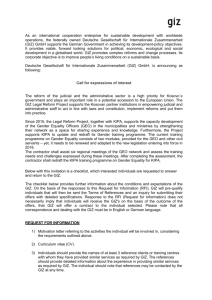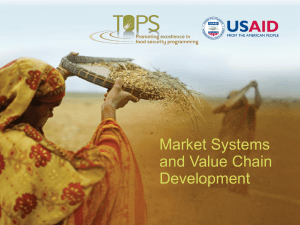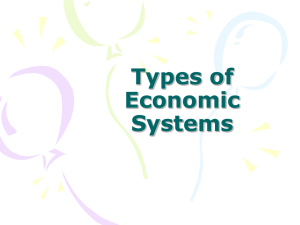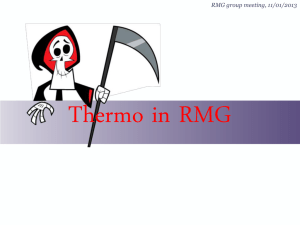Value Chain Upgrading, Management and Productivity
advertisement
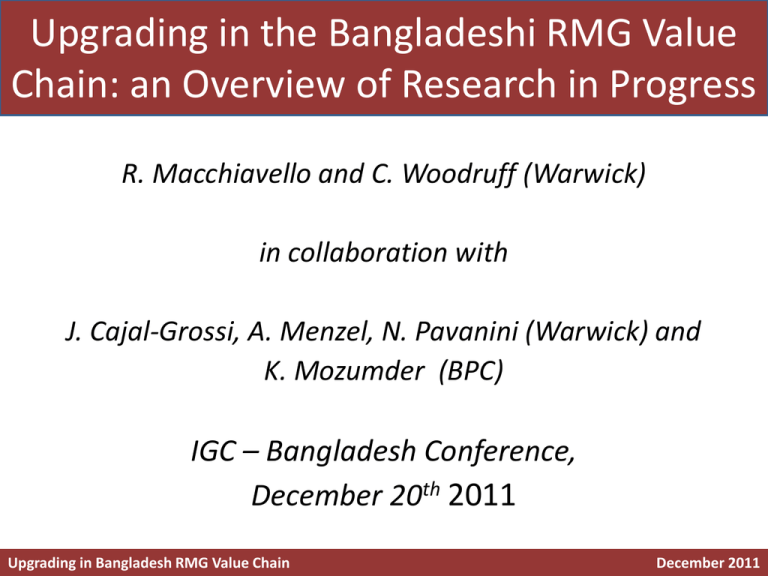
Upgrading in the Bangladeshi RMG Value Chain: an Overview of Research in Progress R. Macchiavello and C. Woodruff (Warwick) in collaboration with J. Cajal-Grossi, A. Menzel, N. Pavanini (Warwick) and K. Mozumder (BPC) IGC – Bangladesh Conference, December 20th 2011 Upgrading in Bangladesh RMG Value Chain December 2011 Project overview • Two interconnected projects: Foreign Buyers and Upgrading in Value Chains Evaluation of GIZ Training Program Administrative data collected by customs on the universe of the industry A RCT evaluating the effectiveness of program training female operators to become supervisors in about 100 factories Upgrading in RMG Bangladesh Value Chains December 2011 Upgrading in value Chains • Policy makers in developing countries care about exports for (at least) two reasons: 1. export revenues generate FX 2. export activity increases incomes - job creation in contexts with low domestic demand, - export activity is (believed to be?) associated with higher productivity • Increased availability of firm level data has allowed significant progress in the analysis of export success in developing countries => exporters use better inputs to produce better outputs and vary the quality of their exports to the destination market Upgrading in RMG Bangladesh Value Chains December 2011 Two Questions 1. As firms move up the value chain, does domestic value addition increase? Trade is normally studied through the lens of revenues – not value addition. From the point of view of income generation for the domestic economy, however, value addition is what matters. Upgrading might require access to inputs for which suitable domestic substitutes are not available. 2. What is the role of large foreign buyers in this process? Exporters access rich foreign consumers indirectly. Design and distribution capabilities reside with large foreign buyers. Do large buyers simply pick winners, or do they develop exporters? What are the rewards associated with accessing higher value added chains? “Buyer-Driven Chains” (Gereffi (1999)). Foreign Buyers and Upgrading in Value Chains December 2011 Context of the Analysis • We hope to make progress on these questions by studying Ready Made Garment (RMG) in Bangladesh. 1. Virtually all countries that have industrialized have started by developing textile sectors - entry into cutting woven, move into more sophisticated knitwear, then backward linkages into textiles, accessories (chemicals and plastic) and, eventually, machines. 2. Bangladesh is the third larges exporter of RMG in the World (after China and Turkey). - Sector employs an estimated 3.5 million workers, mostly women, earning about 2$ per day. 3000+ exporters, phenomenal growth in recent years. Foreign Buyers and Upgrading in Value Chains December 2011 Some Preliminary Results from Input-Output Matches Results are still preliminary, as the cleaning of the dataset hasn’t been completed yet. An extremely long (and tedious) task. Focus on a particular product: men’s and boy’s shirts. More work is needed to define inputs use. More work needed to estimate (domestic) value addition at the product level. Foreign Buyers and Upgrading in Value Chains December 2011 Some Preliminary Results from Input-Output Matches 1. Input prices positively correlate with output prices. This correlation is driven by exporter effects and disappears once buyer effects are controlled for. Controlling for buyer and exporter effects, the elasticity of output price w.r.t. price of the main input is also small. 2. The elasticity is higher for: i) larger (and more high-end) buyers, ii) exporters with more buyers, 3. Input prices ↘ and output price ↗ with relationship age. 4. These correlations are unlikely to be driven by input changes and are unlikely to be entirely driven by product quality Foreign Buyers and Upgrading in Value Chains December 2011 One Interpretation Larger and higher-end buyers exercise more control on the sourcing of inputs; This control comes with low negotiating power of exporters w.r.t. price; But provides incentives to buyers to 1. transfer capabilities to suppliers; 2. search for new suppliers. Foreign Buyers and Upgrading in Value Chains December 2011 Future Work on Administrative Records a) continue the process of data cleaning and collection, b) confirm results above exploring dynamics and other products, c) estimate a structural model of buyer search Foreign Buyers and Upgrading in Value Chains December 2011 Evaluation of GIZ Female Operator Training Program One of the central organising questions of the IGC Firm Capabilities group is productivity dispersion Discussions with many organisations involved in the Bangladeshi garment sector suggest management training in the lower levels – particularly at the line supervisor level – is needed GIZ program DFID-supported programs Various foreign buyers (ASDA, H&M, etc.) Evaluation of GIZ Female Operator Training Program December 2011 The GIZ Female Operator Training Program 6 – week (36 day) training program developed by local consultants in conjunction with GIZ. - Production process - Quality control - Social compliance - Leadership GIZ piloted in 2009, with ~10 factories Evaluation of GIZ Female Operator Training Program December 2011 Research Design 1. Sample of 96 factories: Dealing with heterogeneity of producers - Working with large foreign buyers, highly demanding but below the top end - Identify producers who are ‘almost good enough’ for them 2. Sample of workers: each factory identifies 20 production workers as candidates - Simple diagnostic (literacy/numeracy/Raven test), ranking - Select top two plus 3 of the next six for training - 4 female and 1 male, to disentangle gender from training Evaluation of GIZ Female Operator Training Program December 2011 Timeline 1. 08-10/ 2011: recruitment of factories, 2. 11/2011: baseline for the first 12 factories, 3. 12/2011- 01/2012: first batch of factories receiving training, baseline of “next” factories continue 4. … last batch of factories receive training in 02-03/2012. Evaluation of GIZ Female Operator Training Program December 2011 Main Research Questions and Data 1. Firm level effect of the training 2. Production-line level effect (and mechanism) - there is no randomization at the production line, 3. Worker-level effects: on trainees, line co-workers and line supervisor. To answer these questions we are undertaking a major data collection effort: - innovative survey of workers (20 per factory) - administrative records on production and labour force from the factories Evaluation of GIZ Female Operator Training Program December 2011 Next Steps We see this project as a first step of a prolonged engagement with several industry stakeholders: 1. Training existing supervisors, 2. Training existing managers, 3. Who should pay for the training? 4. Deeper engagement with few factories on labor practices, incentives, etc. 5. Deeper engagement with foreign buyers. Evaluation of GIZ Female Operator Training Program December 2011 A Final Word After so much work, it is frustrating not to have yet results. They will come soon with much more hard work! None of these projects would be possible without the incredible cooperation we are receiving in Bangladesh: from factories, buyers, public institutions, and the generosity of IGC and other sponsors. We look forward to a continued engagement with the country with the hope of contributing to the further upgrading of the RMG sector in Bangladesh Local Researcher interested in collaborating are welcome to contact us: r.macchiavello@warwick.ac.uk and c.woodruff@warwick.ac.uk Evaluation of GIZ Female Operator Training Program December 2011




